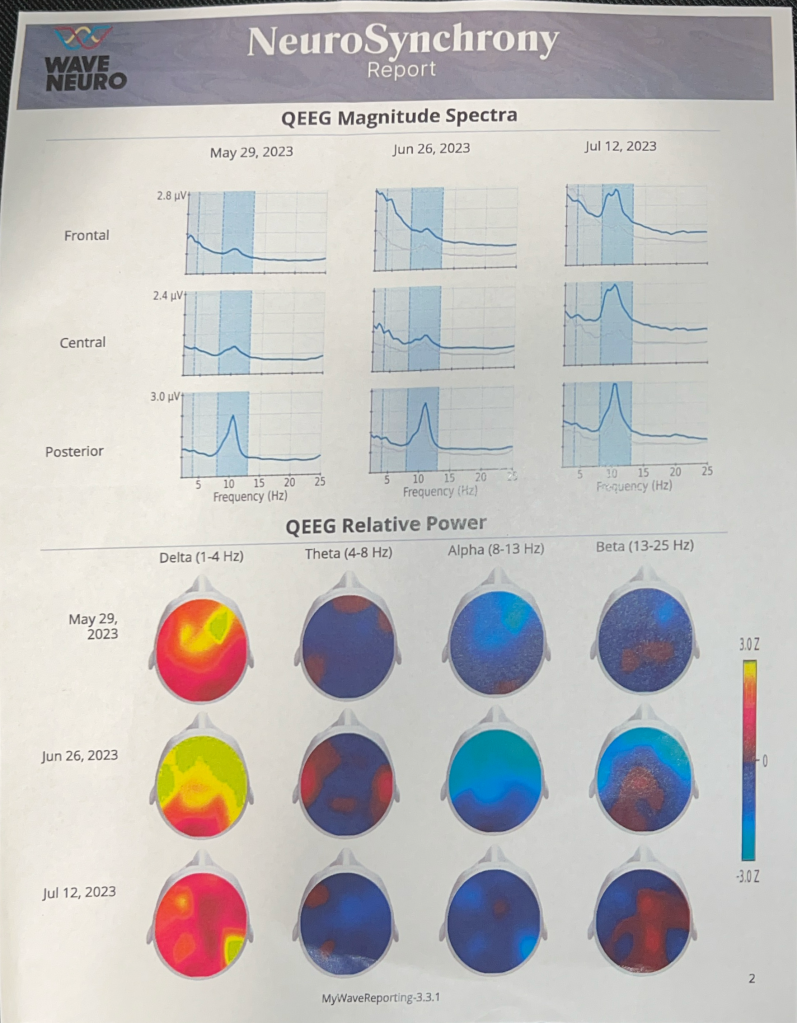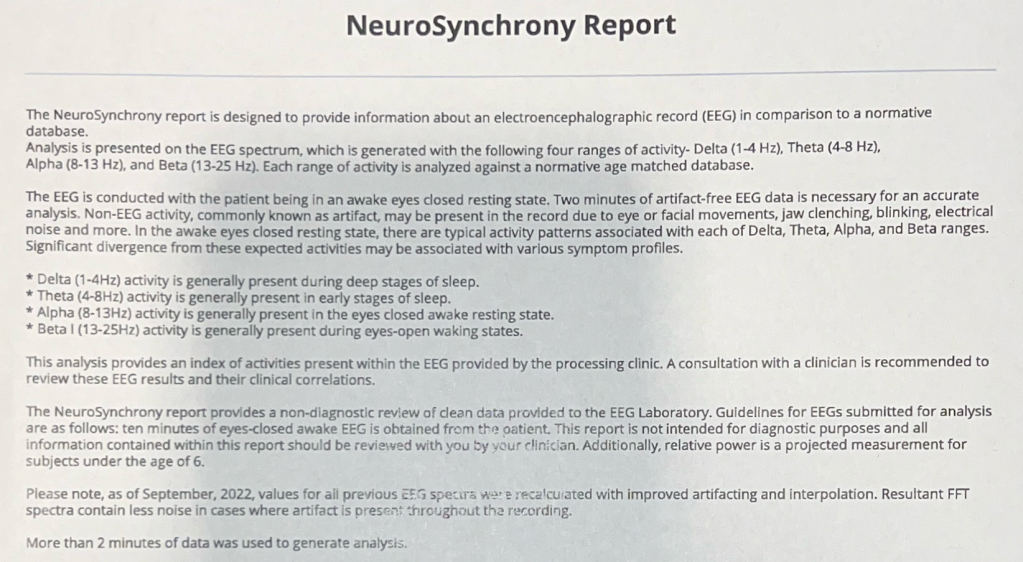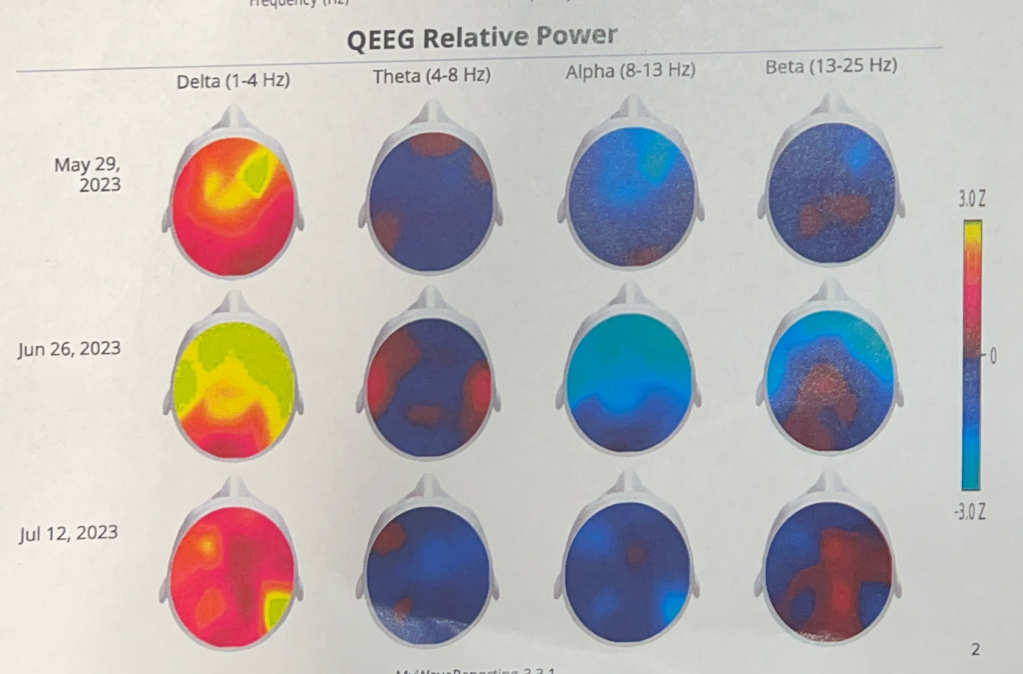This post is about my own experiences and thoughts about eTMS treatment. It should not be used as medical advice or be considered an authoritative source for medical information. If you think TMS/rTMS/eTMS could help you, check with a medical professional for the latest information and steps to get help. If you are a Veteran, First Responder, or Law Enforcement officer struggling with substance abuse, mental illness, sleep disorder, traumatic brain injury, sexual trauma, PTSD, concussions, or other brain trauma, contact eTMS Ohio for treatment options.
So, my planned daily updates have stretched out a little! Here’s all the latest information that’s fit to type.
First, I was a little more regular on TikTok and have made a few posts there. If you want the quick and dirty update, check them out, or you can skip ahead to the reading part.
A couple more weeks
As it was explained to me, eTMS treatment protocol requires a minimum of 10 treatments to be effective, but 30 treatments is the goal. I had a work trip to Puerto Rico last week and the original plan was to end treatment when I left for that trip. But after my second EEG, the doctor asked if I could finish out the 30 treatments. There were indications that some more work needed to be done, so he wanted me to finish out the 30 treatments for maximum benefit. So, I’m back in New Lexington for daily treatments. I’ll be here this week and Tuesday, Wednesday, and Thursday of next week.
After that, I’ll be continuing my free counseling sessions and massages, and can come back any time I need for a “tune up”. The time people take to feel they need those tune-ups varies from a month or two to several years, but either way I’ll be able to keep my brain tweaked and on track.
Back on some drugs, preparing to come off others
Another thing that the doctor and I discussed during our last meeting was my medical marijuana. I’d been having trouble sleeping and I mentioned that I normally took medical marijuana to sleep and hadn’t been since I started living at the treatment center. Now, he’d told me at the start to not change any medications until after my treatment was complete. I hadn’t really considered medical marijuana a “medication” since the prescription isn’t so … prescriptive. But, it’s something I use for sleep and stopping it made me not sleep.
I’d been concerned about the THC affecting the treatment somehow, but the doctor said it doesn’t, and that proper, restorative sleep would have more benefits than any possible side effects of the marijuana. Sleep seems to be somewhat critical in the whole process of resynchronizing the brain. So, I went back on the MMJ, and it apparently made a difference! (See my EEGs below)
During this time I also started talking to my primary doctor about weaning off of my various medications. We agreed to start with reducing my dosage of Strattera and switching my Vyvanse (or possibly back to Adderall because insurance) to an as-needed, shorter acting dosage. It may take time to properly wean off the medications, but eventually I hope to stop several meds that I take because of the issues eTMS is treating:
- Vyvanse/Adderall
- Strattera
- Ativan
- Trazadone
- Medical marijuana
- Prazosin (I take this for my prostate and to help with nightmares. Hopefully it will only need to be for one reason now!)
* I’m using the brand names above because they’re more well-known. I do take the generic version of several of these.
The proof is in the EEG
At the time of the appointment where the doc asked me to extend to the full 30 treatments, I’d had my June 26th EEG. He’d noticed that the posterior alpha waves were still higher than the rest and those should shift with more treatments. The July 12th one showed that happening!
Here’s my latest EEG report.

And here’s the medical explanation of what it all means

The top section shows the magnitude of the various waves in the different regions of the brain. The light blue region on the left of each chart represents the delta and theta waves, and the darker blue region shows the alpha waves. The target of the treatment is alpha waves, and the goal is to have them at equivalent levels in the frontal, central, and posterior sections of the brain.

On June 26th, there was noticeable improvement in the frontal region, which is what we wanted. The doctor noted the spike and large magnitude in the posterior region. This is something he sees with people who can be easily frustrated or get overwhelmed when there are too many options (like me!).
The difference between that scan and July 12th was remarkable! On each chart, you can see a faint grey line below the blue one. This shows the original, pre-treatment magnitude so you can see the shift. Look how all three are at nearly the same level of alpha waves, and the patterns in the frontal and central regions match. That’s what we want! Ideally, all three would look similar, but this is a lot closer to where we want it. (Guess he was right about that sleep thing!)
The other section of the report shows the improvements in a different way.

While the top chart shows voltage and frequency, this one shows relative power. I’m making an assumption here that these terms are the same as in electronics, so the top graphs show the potential signals being transmitted by neurons while the bottom graph shows the amount of signal and current actually flowing through. (This is purely me inferring from my own understanding of electricity, but it sounds reasonable.) According to the doctor, the thing he wants to see is a uniform color throughout each image, especially in the alpha range. And that’s most visible in the latest EEG!

Puerto Rico and my brain
Last week I took a work trip to San Juan, PR, to meet with my team. It was my first time “in the wild” since I started eTMS, so I was curious about how it would go.
While there, I noticed that I was better able to stay on track with tasks I was doing, and I handled unexpected shifts differently. Of course, software engineering is a fluid process, and there are different ways to handle specific tasks. In the past when I’d hit some perceived opposition, either from circumstances or from a different point of view, I had to be very intentional about letting my feelings not get in the way of progress. Last week, though, I was able to go with the flow, deal with change, and contribute productively. It may not have looked very different to people around me, but it felt very different!
What’s not better…yet
Of all the things that are better, the one area I still feel I’m short on is organization and overwhelm. My thoughts feel less chaotic, but my life is staying chaotic with lots of mental and physical clutter around me. This is a thing I’ve been dealing with for years, and is the result of being chaotic and disorganized in my brain for decades. It’s been my number one source of frustration for a very, very long time, and has been part of my lifelong cycle of overcommitting, then trying something new to get it together, then failing and seeing the cycle continue.
I believe this is a chance to actually reset things around me to go along with the brain reset, and this time it’ll stick. But, just like I was advised not to significantly change my medication during the treatments, I don’t want to try to make the changes I desire to make while I’m spending all this time away from home, traveling back and forth, and basically living in a transitory state. After, though, I hope to declutter my space and mind and find even better focus.
What’s next
Next week is my last week in treatment (treatment 30 should be next Thursday), but I feel there’s a lot more story to tell here. Everyone involved in my treatment and the support surrounding it have been wonderful and I feel the vital service they’re providing needs to be shared. I hope to put together a retrospective podcast where I can talk to folks involved in my eTMS treatment, the house where I stay, and other aspects of my live for the last several weeks. Stay tuned for more!
Leave a comment